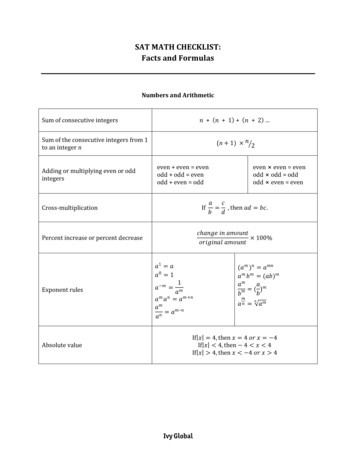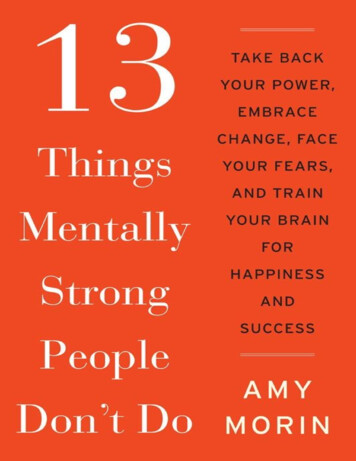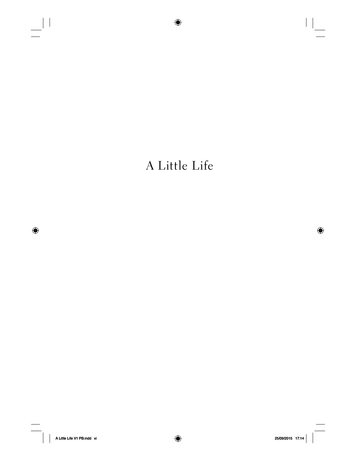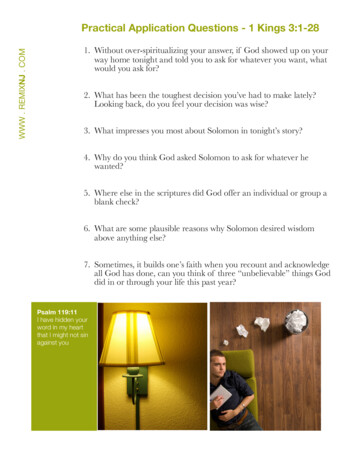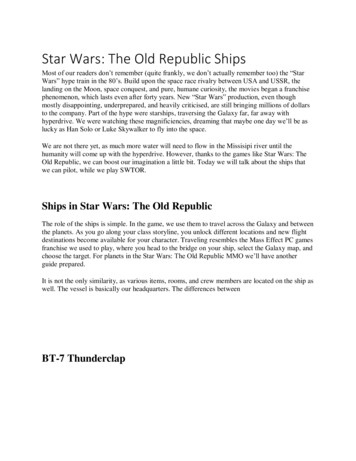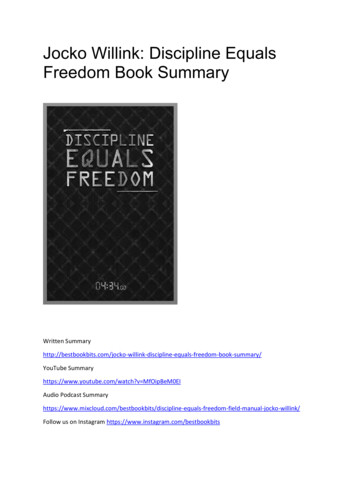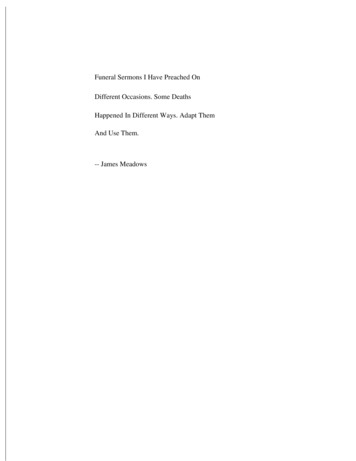
Transcription
“I Don’t Even Remember What I Read”: How Design InfluencesDissociation on Social MediaAmanda BaughanMingrui “Ray” ZhangRaveena RaoUniversity of WashingtonSchool of Computer Science &EngineeringSeattle, Washington, USAbaughan@cs.washington.eduUniversity of WashingtonInformation SchoolSeattle, Washington, USAmingrui@uw.eduUniversity of WashingtonInformation SchoolSeattle, Washington, USArraveena@uw.eduKai LukofAnastasia SchaadhardtLisa ButlerUniversity of WashingtonHuman Centered Design &EngineeringSeattle, Washington, USAkai1@uw.eduUniversity of WashingtonInformation SchoolSeattle, Washington, USAaschaad@uw.eduUniversity of BufaloSchool of Social WorkBufalo, New York, USAldbutler@bufalo.eduAlexis HinikerUniversity of WashingtonInformation SchoolSeattle, Washington, USAalexisr@uw.eduABSTRACTCCS CONCEPTSMany people have experienced mindlessly scrolling on social media.We investigated these experiences through the lens of normativedissociation: total cognitive absorption, characterized by diminished self-awareness and reduced sense of agency. To explore userexperiences of normative dissociation and how design afects thelikelihood of normative dissociation, we deployed Chirp, a customTwitter client, to 43 U.S. participants. Experience sampling and interviews revealed that sometimes, becoming absorbed in normativedissociation on social media felt like a benefcial break. However,people also reported passively slipping into normative dissociation,such that they failed to absorb any content and were left feeling likethey had wasted their time. We found that designed interventions–including custom lists, reading history labels, time limit dialogs,and usage statistics–reduced normative dissociation. Our fndingsdemonstrate that interaction designs intended to capture attention likely do so by harnessing people’s natural inclination to seeknormative dissociation experiences. This suggests that normativedissociation may be a more productive framing than addiction fordiscussing social media overuse. Human-centered computing Empirical studies in HCI;HCI theory, concepts and models; Social media.Permission to make digital or hard copies of all or part of this work for personal orclassroom use is granted without fee provided that copies are not made or distributedfor proft or commercial advantage and that copies bear this notice and the full citationon the frst page. Copyrights for components of this work owned by others than theauthor(s) must be honored. Abstracting with credit is permitted. To copy otherwise, orrepublish, to post on servers or to redistribute to lists, requires prior specifc permissionand/or a fee. Request permissions from permissions@acm.org.CHI ’22, April 29-May 5, 2022, New Orleans, LA, USA 2022 Copyright held by the owner/author(s). Publication rights licensed to ACM.ACM ISBN 978-1-4503-9157-3/22/04. . . DSsocial media, design, social media addiction, dissociation, normativedissociationACM Reference Format:Amanda Baughan, Mingrui “Ray” Zhang, Raveena Rao, Kai Lukof, AnastasiaSchaadhardt, Lisa Butler, and Alexis Hiniker. 2022. “I Don’t Even RememberWhat I Read”: How Design Infuences Dissociation on Social Media. InCHI Conference on Human Factors in Computing Systems (CHI ’22), April29-May 5, 2022, New Orleans, LA, USA. ACM, New York, NY, USA, 13 ODUCTIONPeople sometimes experience reading a page of a book and thenrealizing their mind was elsewhere, engrossed in an unrelated trainof thought. Similarly, many have experienced becoming completelyabsorbed in a movie or video game, resulting in an omission ofexternal stimuli. Daydreaming and other pastimes can also capture attention and dislodge self-awareness. All of these experiencesshare a commonality: they are experiences of normative dissociation [10].Normative dissociation is a phenomenon that encompasses manyseemingly disparate mental states, including daydreaming, fow,and becoming absorbed in watching a movie [9, 10]. What theseexperiences have in common is a narrowing in attention that results in the exclusion (dissociation) of other content from a person’sfeld of awareness, such as thoughts, feelings, memories, and/or
CHI ’22, April 29-May 5, 2022, New Orleans, LA, USAawareness of the external world around them. When dissociating, people experience a diminished sense of volition (i.e., willfulchoice) and loss of self-awareness and refection. As a result, peopletypically only come to realize they have experienced dissociationin retrospect; they come into awareness once self-refection is reengaged [9]. To appreciate the range of experiences that fall underthe umbrella of normative dissociation, consider the following twoscenarios. When reading a book, one may turn the page only torealize, in hindsight, that one did not take in or remember any of thecontent on the previous page. The mind was elsewhere, absorbedin thoughts, feelings, or memories unrelated to the actions taken(reading the book). Equally, one could become so deeply absorbedin what they are reading, that one’s personal thoughts and feelingsare excluded from attention. These instances are united by a deepand narrowed focus, in either one’s own daydreams or the book,such that anything outside of this focus is excluded.Prior literature hints at a connection between normative dissociation and social media use. For example, “The 30-Minute Ick Factor”describes a sense of disgust people report upon suddenly noticingthey have spent a notable amount of time on social media whenthey only meant to check in briefy [73]. In prior work, users describe experiencing “Internet blackout” [41] and compare browsingsocial media to entering a “trance” [47]. Similarly, Olson et al. [53]found that smartphone addiction positively correlates with hypnotisability, and hypnosis is generally agreed to be a dissociativestate [10, 11, 25, 36, 69]. This suggests that normative dissociationmay be related to people’s experiences of technology overuse. Theloss of awareness and control users describe and the internal question of “what just happened” after browsing social media are allcharacteristic of normative dissociation.Of course, these social media experiences are created by design.Tasked with maximizing metrics like time on site and return visits,designers strive to turn social media use into an automatic habitthat requires little conscious control [19, 65]. At the same time,digital well-being researchers have found that changing specifcdesign features of social media apps can promote a greater senseof agency [27, 44], which is not accessible during normative dissociation. This suggests that design can infuence experiences ofnormative dissociation while browsing social media.Therefore, we set out to investigate: 1) people’s experiences using social media through the lens of normative dissociation, and2) how, if at all, design infuences normative dissociation. To accomplish this, we deployed four design interventions on a novelTwitter client, Chirp, created by the research team. These included:custom lists, reading history labels, time limit dialogs, and usagestatistics. In a four-week study, 43 participants used each of fourversions of Chirp for one week. Participants completed experiencesampling questionnaires in-app [18] to measure their level of normative dissociation in the presence and absence of these features.At the end of the study, we conducted interviews with 11 of theseparticipants to further understand user experiences of normativedissociation on Chirp and other social media.We found that users’ self-reported experiences browsing Chirpwere consistent with the normative dissociation model. Participantsdescribed becoming “lost” in the content, disconnecting from theirsurroundings, and “zoning out” or entering a “zombie”-like state.We also found that our design interventions had a signifcant efectBaughan et al.on users’ levels of normative dissociation; all of the designs that weintroduced (including features to organize content into lists, indicate reading history, notify users of their time onsite, or show userstheir usage statistics) signifcantly reduced normative dissociationfor our participants.Our results indicate that designers have the power to both encourage normative dissociation and to disrupt it. While the attention economy incentivizes designers to capture user attention foras long as possible [7], which has lead to a contested narrative of“technology addiction,” [56] our work suggests that people’s naturaltendency toward normative dissociation, coupled with designs thatencourage it, may be a more productive way of describing socialmedia overuse. Further, this work contributes a set of features thatinfuence the likelihood of normative dissociation, supported byempirical evidence. We hope that our fndings can help future researchers, practitioners, and users of technology gain more nuancedunderstanding of the role normative dissociation plays in socialmedia overuse and how to address it.2RELATED WORKHere we defne normative dissociation and describe how it relatesto social media use and “addiction.”2.1Dissociation in Everyday LifeMany scholars believe that dissociation exists on a continuum fromordinary, everyday experiences to more distressing, trauma-basedsymptoms that defne dissociative mental health disorders [6, 9,26, 43]. In this study, our focus is specifcally on everyday experiences of dissociation. Although some work refers to these routineexperiences as “normal dissociation” (e.g., [69]), we adopt Butler’sterminology of normative dissociation so as not to imply that somedissociation is “not normal” and to avoid stigmatizing already misunderstood disorders. Across the spectrum, all dissociative experiences share: (1) absorption, the focusing of the lens of attention toa narrow range of experience; and (2) diminished self-awareness,often accompanied by a reduced sense of time and control and agap in one’s memory [10]. As Krippner and Powers [38] say,“‘Dissociative’ is an English-language adjective thatattempts to describe reported experiences and observedbehaviors that seem to exist apart from, or appear tohave been disconnected from, the mainstream, or fow ofone’s conscious awareness, behavioral repertoire, and/orself-identity. ‘Dissociation’ is a noun used to describea person’s involvement in these reported dissociativeexperiences or observed dissociative behaviors.”One common form of normative dissociation is “highway hypnosis,”in which, on a long stretch of highway with few demands on conscious awareness, people can drive a car, respond to external eventsin an expected and safe way, and have no conscious recollection ofdoing so [20].An increasing body of research has shown that experiences ofnormative dissociation are more common than previously thought [9,10, 12]. Butler [9, 10] identifes two ways in which people enter normative dissociation, which we describe in Fig. 1. People passivelyenter dissociation when they spontaneously slip into an unplanned
“I Don’t Even Remember What I Read”: How Design Influences Dissociation on Social MediaEntry pointCHI ’22, April 29-May 5, 2022, New Orleans, LA, USANormative dissociationExit pointPassiveTotal absorptionOrdinary attention restoredSpontaneous absorption such asdaydreaming and mind-wandering.Often occurs during routinizedactivities such as driving, showering,etc.Attention is focused on a very narrow range ofexperience. This excludes or ‘dissociates’ context that isordinarily associated with experience, often resulting in: Reduced self-awareness Reduced sense of agency Reduced sense of time Reduced memory of the experiencePeople realize their absorption inhindsight, often accompanied by asense of “I did what?” or “How did I gethere?” Flow states are positivelyappraised and affirming Zone states are negativelyappraised and depletingActivePlanned escapes into absorptiveexperiences, often recreationalactivities such as films, games, orreading. May be adaptive as a form ofstress relief, or maladaptive as a form ofavoidance.Flow statesZone statesAbsorption in personallymeaningful activities, suchas creative endeavorsAbsorption in personallymeaningless activities,such as gamblingFigure 1: Normative dissociation can be understood as a process [8]. It can begin either as an active choice or passively, throughspontaneous absorption. Once totally absorbed, the individual’s attention is focused on a very narrow range of experience. Itis typically only once ordinary attention is restored that people realize they have dissociated.experience, such as daydreaming. This is often described as “spacing out” and can be secondary to another activity that is low incognitive demand, for instance, driving on a highway (i.e., highwayhypnosis), taking a shower, or playing a simple computer game.The resulting experience involves absorption in an internal world,along with a loss of self-awareness and awareness of the passage oftime. These moments are a common and benefcial part of everydaylife, and engaging in simple activities that allow for daydreaming(i.e., normative dissociation) can promote creativity and problemsolving [4]. Daydreaming also allows for “dishabituation” whichenhances learning by providing short breaks from tasks [62].In contrast, when people actively enter normative dissociationthey intentionally seek an escape in an absorbing activity thatpushes the concerns of daily life to the periphery of awareness.Many people “actively” dissociate by listening to music, watchingmovies, or reading [5, 12, 21]. This may serve an adaptive function, as becoming absorbed in a recreational activity can reducestress and improve mood [9, 10, 43, 66]. It is possible that peopleencounter both forms of dissociation through their social mediause: People may use social media to actively enter a dissociativestate or passively slip into a dissociative state while scrolling.A third and rarer experience according to Butler [9, 10] is positivedissociation. These experiences involve intense absorption withactivities of personal signifcance. Flow states [9, 51] are an example,as an individual is challenged just up to the limit of their abilitiesand must be totally absorbed to realize peak performance [51].Digital game designers have found fow theory to be a helpfulguide to creating immersive experiences that provide pleasure andhappiness [14–16].Yet, dissociation is not always a positive and self-actualizingexperience. For example, Schüll [64] cautions that Las Vegas gambling devices are designed to draw people into “the machine zone,”a state that gamblers experience as nearly identical to a fow state,except that in the end they feel depleted instead of afrmed. Thejournalist Alexis Madrigal extends this to “The Facebook Zone,”describing the feeling of being hypnotized and regretting lost timein its aftermath [48]. Rather than conceptualizing “fow” and “thezone” as two separate experiences, it is useful to recognize that theyare both forms of normative dissociation. The crucial diference andquestion is how the interaction between the user and design resultsin a feeling of positive afective valence and intrinsic value in thecase of “fow” and a negative valence with little to no intrinsic valuein the case of “zone” experiences.Butler and Palesh [12] note that people spend substantial timeparticipating in potentially dissociative recreational activities, whichmay be appealing because of the relief and restoration they cansometimes ofer. They state that the pursuit of dissociative activities is so common and second-nature, “that its role in our lives hasnot been fully appreciated or examined empirically.” Therefore, weexamine people’s experiences mindlessly scrolling and becomingabsorbed in social media through the lens of normative dissociation.2.2Social Media Breaks: Tool for MoodRegulation or Harmful Compulsion?Mood management theory [77] proposes that media content has astrong efect on afect and arousal, and selective exposure to mediacan lead to mood optimization [59], which is similar to the ideaof normative dissociation as a form of escape that helps in mentalrecovery [9]. Research has demonstrated that media consumptioncan help in the restoration of depleted resources [60], and that theefects of media-induced recovery are linked to outcomes such asincreased vitality, enjoyment, cognitive performance, and subjectivewell-being [59–61]. Lukof et al. [45] found that smartphone appsare sometimes used as a micro-escape from unpleasant situationsand provide helpful recovery, even when the user themselves deemsthe content of the app “mindless” (e.g., playing a game like CandyCrush). Therefore, it appears that in at least some instances, socialmedia consumption can help people recover and improve theirwell-being and subsequent task performance.
CHI ’22, April 29-May 5, 2022, New Orleans, LA, USAHowever, social media also tempts procrastination and is a frequent source of self-control struggles [47, 59]. Many people procrastinate through their use of social media [58, 59], because procrastination can provide a short-term mood boost [67]. However, theboost in momentary happiness that people receive from yielding totemptations that confict with another goal is considerably smallerthan when there is no conficting goal. This “spoiled pleasure” efectis attributable to the negative self-evaluation and guilt that followswhen people snap back to reality and realize that their originalgoals remain unaccomplished [30]. Researchers have linked procrastination to dissociative absorption [68]. As Butler [9] states,“Dissociation may be seen as a psychological crutch that allows theindividual to disengage from the tension and action of the present.Those with the capacity to dissociate can evade awareness of aversive. . . inputs. . . and the burden of volition.”Social media may be a particularly attractive avenue for escapefrom the burden of volition due to various aspects of its designthat are intended to keep users “hooked” on the experience [19].Ritualistic gratifcations are introduced by design through “variablerewards” which keep users “on the hunt” for new content [19].Oulasvirta et al. [55] found that platforms that give users quickaccess to information rewards encourage a “checking habit,” inwhich the user frequently and mindlessly checks back on the experience. This is explained by the fact that information can engagethe brain’s reward system similarly to anticipation of winning alottery or eating food [37]. Variable rewards cycles are facilitatedthrough interface design patterns that are common across socialmedia platforms, including infnite scrolling [57] and auto-play [44].The abundance of design features which encourage a “checkinghabit” [55] and ritualistic gratifcation [19, 28, 37] have led many researchers to debate whether social media use is addictive [73]. Somestudies have found that weaker impulse control predicts heaviersmartphone use, which supports the addition hypothesis [75, 78].However, other work argues everyday leisure activities like social media use should not be considered “addictions” unless theyalso lead to distress and functional impairment [33, 56], and thenarrative of technology addiction needs to be carefully examinedwithin scholarly communities [40]. Across the board however, it isgenerally agreed that social media design does encourage compulsive use [19, 37, 45, 55, 57], and many users are not satisfed withritualistic usage patterns [44, 45, 73].Fortunately, design can play a role in helping people reducetheir ritualistic and meaningless technology use [44, 46, 47]. Forexample, designs can discourage overuse by adding micro-frictionson top of an existing design [17], e.g., nudges [52, 57] or lockoutmechanisms [34, 35]. Popular screen time tools, like Apple’s ScreenTime on iOS and Google’s Digital Wellbeing on Android, applythese approaches to all apps on their platforms. Prior work labelsthese standalone tools external supports [44]. In contrast, anotherpromising approach to reduce meaningless technology use is toprovide internal supports [44] to prevent the features within anapp from inhibiting awareness and refection in the frst place.Design researchers have explored removing the newsfeed fromFacebook [47], removing autoplay [44], and helping users plan outtheir content consumption in advance [27]. These design interventions have found success in increasing users’ sense of controland satisfaction when using social media. Here we ask how socialBaughan et al.media design might also infuence the experience of normativedissociation.3METHODSTo evaluate if people dissociate while using social media and howdesign decisions might systematically afect normative dissociation,we developed four versions of a custom Twitter client, which wecalled Chirp1 , based on the open-source project Twidere2 . Belowwe describe our deployment, including the experience samplingand interview data which informed our fndings.3.1The Chirp Twitter ClientChirp allowed users to login to their own Twitter accounts andinteract with their regular Twitter content, as shown in Fig. 2.We created four versions of Chirp through a user-centered designprocess with the goal of improving users’ sense of agency over theirTwitter use. We conducted (1) a Twitter user survey, (2) an interviewand sketching activity with a panel of four expert designers, and (3)an analysis of alternate Twitter platforms’ designs. Through theseprocesses, we developed a set of “internal” and “external” designinterventions to increase users’ sense of agency. As dissociation isdefned by a decreased sense of volition, it is ftting to use thesesame designs to evaluate if and how design impacts normativedissociation on social media.1 https://github.com/uelab/Chirp2 bcFigure 2: Interfaces of Chirp: a) the home page, which showstweets from all accounts followed. Tweets are displayed inchronological order; b) interface for composing a tweet; c)settings page, where the user can confgure the user interface and other options provided by Twidere.
“I Don’t Even Remember What I Read”: How Design Influences Dissociation on Social MediaThe internal interventions fundamentally changed how usersconsume tweets, whereas the external interventions gave userstools to monitor their use [44]. We created two separate collectionsof internal and external interventions, such that each collectioncould be independently added to Chirp. This produced four diferentversions of the app: (1) one with only the internal interventionsenabled, (2) one with only the external interventions enabled, (3)a control version in which no interventions were present, and (4)a combined condition with all internal and external interventionsenabled.Internal Interventions. When internal interventions were present,a reading history label, indicated when a user had scrolled to a pointwhere they had already seen tweets below the label (Fig. 3a). Usershad to create lists to conceptually organize subsets of accounts theyfollow (Fig. 3b, c), creating an interface that segments tweets intoseparate, organized feeds. We also removed popular tweets (whichwere present in the baseline version) and enabled users to flter outretweets and replies.External Interventions. These included a usage statistics page,a side pane users could opt to view which displayed time spent onChirp, number of tweets consumed, and other usage information(Fig. 3d). Separately, we implemented a time limit dialog feature(Fig. 3e) which appeared every 20 minutes, displayed the cumulativetime spent during the current session, and asked the user if theywould like to continue using Chirp. The user could ignore this timelimit by selecting “continue” or exit Chirp by selecting “exit.”3.2based on the participant ID. We used a Latin square design tocounterbalance the ordering of app versions participants used. Atthe beginning of each week, Chirp would change its interface andfunctionality based on the participant ID. We also sent out an emailthat included a tutorial (in video and pdf formats) about featuresfor that week and encouraged participants to use the features. Toensure participants successfully used the features, we required themto upload a screenshot of each feature at the start of each week. Atthe conclusion of the deployment, we conducted interviews with 11participants via Zoom. We selected this number of participants toreach data saturation; as our n of 11 is consistent with the averagesample size required to elicit stable themes [22] and with the averagesample size in published studies in HCI [13]. We probed usersfor their experiences mindlessly using Chirp or using Chirp andrealizing they hadn’t paid attention to their surroundings for severalminutes. We also asked if users had these experiences on othersocial media sites, and how it impacted their relationship with socialmedia. We closed with questions about whether design featureshelped them recognize when this was occurring. These interviewslasted roughly 30 minutes.3.2.1 Metrics. We recorded users’ behavior at two levels of granularity. All of the data displayed in the Chirp usage statistics interface(Fig 3d), such as time spent on Chirp, number of app opens, numberof times the Chirp usage statistics page was viewed, and number oftimes the time limit dialog was ignored or used to exit Chirp wererecorded as daily totals. We recorded 476 logs of user activity.We also recorded the time spent viewing the various feeds (homeor lists) and time spent viewing feeds after the user has crossedinto their history of previously read tweets. Unlike the other loggedProcedureEach participant used Chirp for a total of four weeks, using eachof the four versions of Chirp for one week. At the end of eachweek, Chirp automatically adjusted its interface and functionalitycCHI ’22, April 29-May 5, 2022, New Orleans, LA, USAdeabFigure 3: Implementation of the design interventions to reduce or disrupt normative dissociation. Internal interventions included (a) reading history labels and (b, c) custom lists. External interventions included (d) usage statistics and (e) a time limitdialog.
CHI ’22, April 29-May 5, 2022, New Orleans, LA, USAdata, these were recorded per session and were not aggregated. Wecollected 8880 logs of activity related to reading tweets.We also implemented notifcation questionnaires based on theexperience sampling method (ESM) [18] to collect in situ feedbackfrom the users. The ESM questions frst appeared to users afterthree minutes of use and appeared again every 15 minutes. Ofthese ESM questions, several were used in a separate project andare not analyzed here. One was of interest to our project, whichstated “I am currently using Chirp without really paying attentionto what I am doing.” Participants could respond on a Likert scaleof 1 (Strongly Disagree) through 5 (Strongly Agree). This questionwas adapted from the Dissociative Processes Scale [23] (DPS), inwhich an item states, “I often seem to do things without really payingattention to what I am doing” and allows people to respond on thesame scale. Unlike other instruments for measuring dissociation,which are designed for dissociative disorders, the DPS is designedto assess common, everyday dissociative tendencies. It consistsof three subscales: obliviousness (automaticity and mindlessness),detachment (depersonalization and derealization), and imagination(absorption and fantasy). Our question is from the “obliviousness”subscale. If the participant submitted multiple ESM responses perday, the average daily score was recorded.3.3ParticipantsWe recruited English-speaking participants across the U.S. via email,online forums, and Mechanical Turk. In recruitment emails, westated, “We are interested in features that lead people to spend theirtime in ways that align with their personal goals,” or “We want tostudy how diferent features afect your experience and sense of controlwhen using Twitter.” Participants were required to: 1) live in theU.S., 2) own an Android smartphone with the Twitter app installed,3) spend a minimum of 10 minutes per day on Twitter, and 4)spend 10% or more of their time on Twitter on their smartphone.The participants recruited from Mechanical Turk were additionallyrequired have a task approval rating greater than 99%, with over1000 approved tasks.Those eligible received an Android apk fle via email to installChirp on their phone. In total, 51 participants enrolled the studyby installing Chirp on their phone, and 43 of them (19 women, 23men, 1 non-binary person) fnished the month-long deployment.Of these 43, 39 were recruited from Mechanical Turk, and 4 wererecruited from an email list. The age range was 18 to 63 years old(mean 33.7, sd 9.4). All participants had used Twitter for overone year except for one person who had used it between 6 monthsto a year. Twenty six participants used Twitter for 5-60 mins perday, ten for 1-2 hours per day, and seven for more than 2 hours perday. Participants received 10 for fnishing the frst week, 10 forthe second, 20 for the third, and 80 for the last week (in total 120).The 11 participants we interviewed were selected because they usedChirp more than three days per week during the deployment. Theywere compensated with an additional 15 Amazon gift card. Ten ofthe interviewees were from Mechanical Turk, and one was froman email list. We interviewed participants 3, 13, 15, 16, 27, 28, 30,31, 33, 35, and 43. All participants were compensated at the samecompensation rate regardless of where they were recruited from.Baughan et al.3.4Analysis3.4.1 Experience Sampling Datasets. To analyze how user behaviorcorrelated with the ESM question, we generated two datasets ofuser behavior in Chirp. The frst dataset contained 8,880 logs ofreading activity, including whether they were scrolling throug
CHI '22, April 29-May 5, 2022, New Orleans, LA, USA Baughan et al. awareness of the external world around them. When dissociat-ing, people experience a diminished sense of volition (i.e., willful
